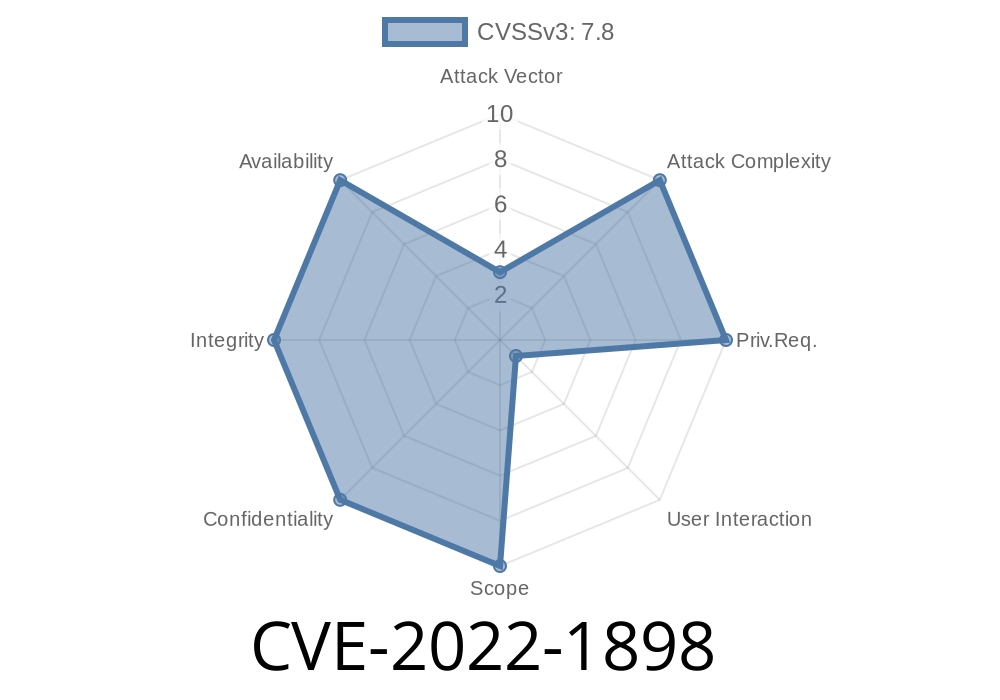Hey folks! Today, I'll be discussing a critical vulnerability known as CVE-2022-1898, which exists in the GitHub repository vim/vim prior to version 8.2. This vulnerability is a "Use After Free" issue, which may potentially be exploited by attackers to execute arbitrary code, causing severe damage to the system. In this post, I'll be breaking down the details of this vulnerability and providing code snippets, as well as linking to original references to help you better understand this issue.
Background
Vim is a popular and highly configurable text editor used across various platforms, including Unix, Linux, and macOS. The vulnerability CVE-2022-1898 is a result of a Use After Free issue found in the underlying codebase of Vim. To get an understanding of what this means, let's take a closer look at the concept of Use After Free.
What is Use After Free?
Use After Free (UAF) is a type of memory corruption vulnerability where a program continues to use a memory block after it’s been 'freed' or deallocated. In simple terms, when a program no longer needs some memory, it's supposed to release it back to the system so other programs can use it. However, if the program mistakenly continues to use that memory after releasing it, it can lead to serious issues.
This can potentially allow attackers to execute arbitrary code, read sensitive information, or even crash the system, depending on the circumstances.
CVE-2022-1898 Vulnerability Details
Now that we've covered the basics, let's dive into the details of the CVE-2022-1898 vulnerability in vim/vim. The vulnerability specifically affects the code responsible for parsing window and buffer objects. When these objects are improperly handled, they can lead to a UAF scenario, which then can potentially be exploited by an attacker.
Here's a code snippet illustrating the vulnerable part of Vim's codebase
/* vim/src/window.c */
void win_free(win_T *win, tabpage_T *tp)
{
...
/* Remove the window from the list of windows. */
if (win->w_prev != NULL)
win->w_prev->w_next = win->w_next;
...
if (tp == curtab) {
...
} else {
/* use tp->tp_firstwin in other_tabpage() and win_id2tabwin() */
if (win->w_next == NULL && win->w_prev != NULL)
win->w_prev->w_next = NULL;
}
...
}
As you can see from this snippet, there's a possibility of using the win->w_next object after it's already been freed. This happens at the win->w_prev->w_next = NULL; line.
Exploiting the Vulnerability
While this post won't provide a detailed exploit for this vulnerability, it's important to understand that such a vulnerability can be exploited by creating specially crafted input that would trigger the UAF scenario mentioned earlier. This might be in the form of a malicious file loaded by Vim, or possibly by input provided directly to Vim through the command line or other means.
For more information regarding this vulnerability, consider referring to these original sources
1. CVE-2022-1898 Official Entry
2. vim/vim GitHub Repository
3. Vim Changelog
Conclusion
CVE-2022-1898 is a critical Use After Free vulnerability in the vim/vim GitHub repository affecting versions prior to 8.2. It's crucial for developers and users to understand and address this issue, as its exploitation can have severe consequences. Make sure you keep Vim updated to the latest version to prevent potential security threats.
Timeline
Published on: 05/27/2022 09:15:00 UTC
Last modified on: 08/21/2022 06:15:00 UTC
